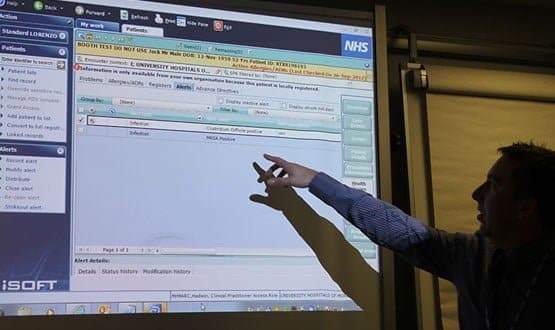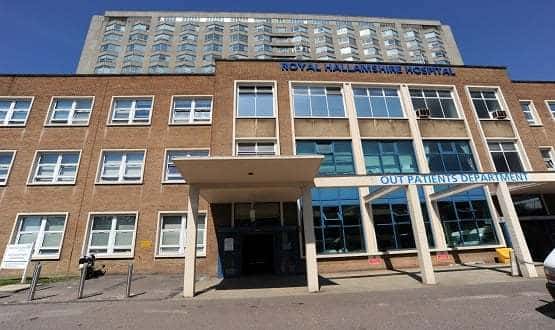Think again about Lorenzo
- 15 October 2012

Over the past four years, University Hospitals of Morecambe Bay NHS Foundation Trust has been under the spotlight as the key reference site for Lorenzo Release 1.9.
This, of course, is the new electronic patient record system that CSC was contracted to deliver to the NHS under the National Programme for IT in the NHS.
And that made success at Morecambe Bay a make or break condition on CSC retaining its local service provider contracts for the North, Midlands and East of England.
The resulting press scrutiny has been tough, and has included extensive reporting from eHealth Insider; but the trust is now keen to talk about what it has achieved.
It already runs popular monthly NHS demo days and recently invited EHI editor Jon Hoeksma to visit, meet the team behind the project and learn more about the progress of its Single Patient Record programme. It will also present at EHI Live 2012.
“We run monthly NHS events, and when people first come in they smile; but by the end they are impressed by what we’ve done,” says Steve Fairclough, the trust’s seasoned head of health informatics.
A ten year programme
Morecambe Bay gave Lorenzo a ‘soft landing’ back in November 2008, when it deployed an earlier version of the software – Release 1 – on just one medical ward at Furness General Hospital.
It went on to replace its old iPM system with Lorenzo 1.9 – the first version with a patient administration system in it – in November 2010.
The implementation ran into various issues, so it was another year before Fairclough could tell the board “it works!” – and start to add further functionality.
Still, Fairclough says: “We see this as a ten-year long-term programme.” And Patrick McGahon, director of service and commercial development at the trust, adds: “This is not an IT project; we want to move to a paperless system.
“This as a major transformational change that is already resulting in key developments like immediate discharge summaries.”
Immediate discharge summaries, populated from Lorenzo, are now sent electronically to GPs and viewable by trust clinical staff.
Working towards paperless
Morecambe Bay covers 1,000 square miles, with three main hospitals in Barrow, Kendal and Lancaster.
Its new eHospital strategy is based around using the Single Patient Record to create a paperless integrated healthcare economy, making use of a portal to tie systems together.
This includes using the EMIS/INPS Medical Interoperability Gateway to link to GP systems. GP record summaries are now available in the emergency care department in Barrow.
The trust plans on making further use of the MIG and other integration tools to better integrate with a range of providers.
It already works closely with Blackpool Teaching Hospitals NHS Foundation Trust, which operates community provider services in North Lancashire.
“Our hospitals are very disparate and our patients move around more quickly than patient records,” says Dr Colin Brown, a specialist in clinical gastroenterology. “Paper can’t keep with the pace of change.”
Lots done, lots still to do
Fairclough says the roll-out of Lorenzo R1.9 is 70% complete as there are further modules to be deployed, and these are expected to be completed within 12-18 months.
“We’re not far off having a full EPR,” he says. “Since 2010, the organisation has used Lorenzo R1.9 exclusively for PAS, diagnostic reporting and business forms.”
He describes the version in use so far as Lorenzo “thin slice”, which provides full patient administration and key documentation, particularly immediate discharge summaries and guaranteed wait times.
So far it includes the PAS, A&E, immediate discharge summary, inpatients, outpatients, to take out medicines, letters, pathology results, radiology, endoscopy, and diabetic screening. In addition, the system has a full data warehouse with live reporting.
Still to come are inpatient prescribing and medication administration, day care, registers, care plans, maternity and clinical noting.
| What is in Lorenzo R1.9 at Morecambe Bay | |
| PAS | Letters |
| A&E | PAthology results |
| Immediate discharge summary | Radiology |
| Inpatients | Endoscopy |
| Outpatients | PACS viewing |
| To take out medicines | GP summary via MIG clickthrough |
| Still to come | |
| e-prescribing | Care Plans |
| Clinical noting | Maternity |
| Day care | |
| Registers | |
| Outside scope Lorenzo ‘dropped’ | |
| Theatres | Multi-resource scheduling |
Fairclough says that before the trust committed to take Lorenzo 2008 it tested the market to evaluate what else was available “and concluded that Lorenzo was the best system” around.
He says that although it has taken longer to get Lorenzo than originally hoped it has been worth the wait. “By being first we’ve been able to ensure we get a system that works for us and help shape national development.”
Getting faster
More than 4,500 staff have been trained on the system, with more than 600 using it concurrently every day using smart cards. There are up to 1,500 unique users daily.
Users say it can still be a bit slow at peak times, particularly between 10 am and 11.00am when junior doctors do their discharges. However, they also say that it has got better.
Dr Laura Gould, a junior doctor at Lancaster General Hospital’s medical assessment unit, was one of those to show EHI how she uses the system.
“The most useful feature are immediate discharge summaries. We can access all of the medical records and put the data into the discharge summaries – so no typos.”
Dr Gould adds: “If we can link up with GP systems and get information on allergies and current medications that will be even more useful.”
Adding clinical content
A key milestone will come in November, when the A&E department at Lancaster goes live with Lorenzo. Barrow’s A&E went live in July. Maternity and advanced bed managment are due to follow at Lancaster shortly afterwards.
The trust is also now making progress on electronic prescribing, with initial efforts focused on to take out medicines – which has proved a huge project at the trust.
“TTO medicine management is now live across medicine at Lancaster Hospital,” says Dr Brown. “And inpatient medicines administration is now being tested.”
He said the trust is also launching a project to look at requesting diagnostics. “We already have 100% GP requesting of tests,” says Dr Brown.
Another major, on-going programme of work is to add more ‘clinical content’ to Lorenzo in the shape of assessment forms and documents, as an initial step to the eventual goal of developing full clinical noting.
Dr Brown says that the trust is now able to rapidly author much of this clinical content without needing to refer back to CSC.
He adds that while in the past he was frustrated by the slow progress under NPfIT, with its layers of bureaucracy, things have speeded up dramatically now the trust has a direct relationship with the company.
“Under NPfIT things just took too long; we’re much more agile now. Everything has got quicker and we understand the process better.”
Updates to the software are now added on a three-month release schedule, though Dr Brown says he’d still like to see these come out faster.
Fairclough says that he has an in-house development team able to do much with Lorenzo: “Though I’d still like it to be bigger.”
Working closely with CSC
In September, after months of negotiations, the Department of Health finally signed a new deal with CSC.
As part of the agreement, some important elements of Lorenzo have been dropped; theatres and multi-resource scheduling are both ‘out of scope’.
Yet all of the Morecambe Bay team spoke of a strong partnership relationship with CSC and shared set of objectives.
One example of the partnership is a ‘skunk works’ project to develop a tablet version of Lorenzo that gives mobile access to some of the commonly used features. A prototype is currently being evaluated at the trust.
Asked to offer lessons for others contemplating following a similar path Fairclough says: “It absolutely requires strong project management.” He adds that delivering real benefits to users is also essential.
McGahen says that initially existing processes were replicated in the new system and only now is the trust beginning to use the new system to change processes.
Rumours and reality
If implementing a huge project under national scrutiny was not hard enough, the trust has had to cope with some self-inflicted problems over the course of the project.
In late 2011, it became apparent that the trust management of patient appointments had massively failed. The trust found it had 19,000 patients, including cancer patients, waiting longer than they should.
Fairclough and Brown are adamant that the problems had nothing to do Lorenzo, but rather needed the new Single Patient Record to fix them.
Dr Brown admits it was a question he asked: “The first question I asked was ‘please don’t tell me this is a Lorenzo issue’. And it wasn’t.” He adds: “Lorenzo is actually unique in providing a guaranteed access date.”
The trust’s operation director goes further and says that Lorenzo has been key to fixing the problems. “We have improved as a trust as a result of Lorenzo.”
He says that growing use of Lorenzo is leading to significant patient benefits. For instance, the entire infection control team now uses Lorenzo and has got rid of paper entirely.
“Now when there is a positive result of MRSA it’s in the patient’s record, and if they are admitted into A&E it can be seen.” He says it has contributed to a fall in MRSA instances from 22 to three to four a year.
Dr Brown admits to having been infuriated and perplexed by some of the national media coverage the trust’s Single Patient Record project has received, saying it was far removed from the real achievements locally.




